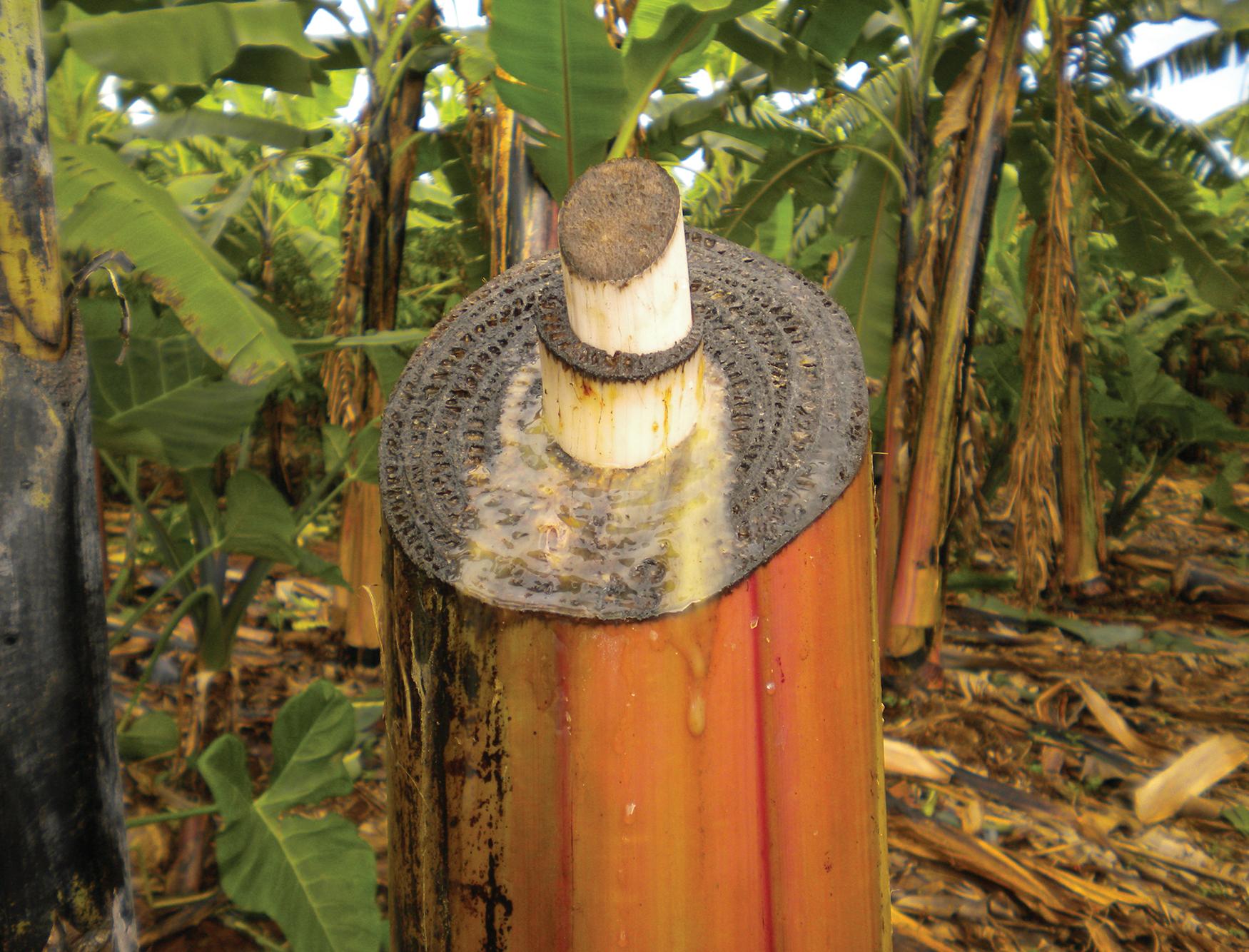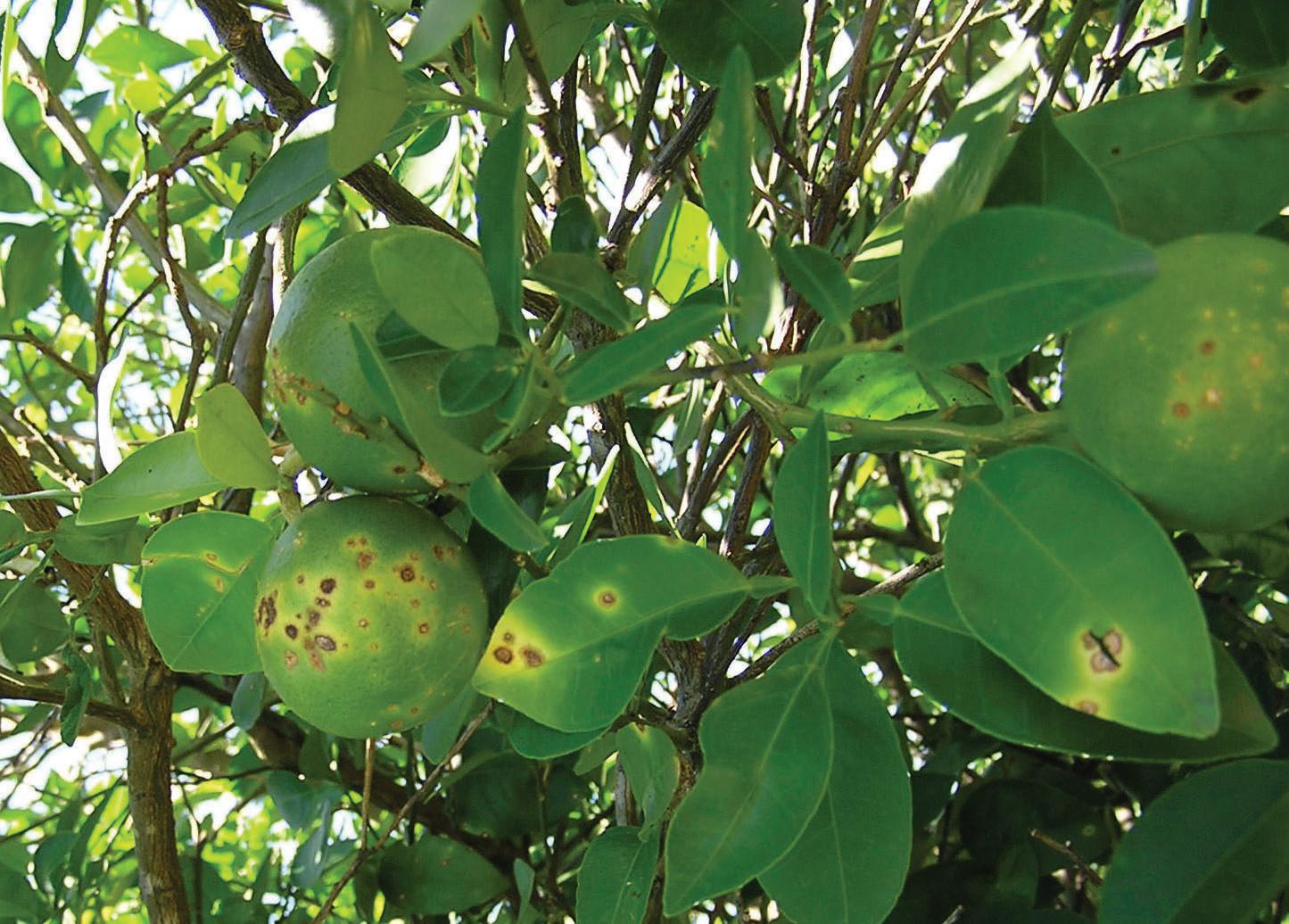






























A. Sharma, J. B. Jones, G. W. Sundin, and S. A. Miller
To identify the causal bacterium in a diseased plant sample, the first step is to try isolating it from the host in pure culture . The steps for bacterial isolation in pure culture are presented in section 2 While many plant pathogenic bacteria grow on standard nutrient media, some do not The strategy for identification of bacteria differs depending on their ability to grow on standard media .
Bacteria that grow on standard media can be identified to genus level by using several biochemical tests Table 2.1 lists bacterial plant pathogens that can be grown in standard media along with some distinguishing properties for identification . The table presents general characteristics for each genus rather than exceptions . For more precise diagnostics, please refer to the corresponding chapters on specific genera
Some bacteria have complex nutritional requirements and will only grow on media amended with specific nutrients or on diluted nutrient media . These bacteria are referred to as fastidious prokaryotes . The complex or diluted media on which these fastidious prokaryotes grow also serve the purpose of identification of these bacteria to genus and/or species Several other bacteria have not yet been successfully grown outside their hosts and are maintained by inoculating host tissue or host tissue extract (Sechler et al . 2009) . Electron microscopy and serological or molecular techniques are used for identification of fastidious and nonculturable bacteria Table 2.2 lists some morphological characteristics and culture media used for identification of common fastidious and nonculturable plant pathogenic bacteria .
In many cases, identification of isolated bacteria is not sufficient to establish whether or not the host–bacterium relationship is pathogenic Koch’s postulates must be satisfied . For this, a pure culture of the bacterium is inoculated into a healthy host, which should result in symptoms similar to those in the host from which it was isolated . Finally, the bacterium must be isolated from the newly infected host, and the cultural properties must be identical to those of the original pure culture .
TABLE 2.1 Characters used to differentiate genera of plant pathogenic bacteria that grow on standard media
Bacillus
Clostridium
Rhodococcus Streptomyces
Curtobacterium
Clavibacter
Pseudomonas Ralstonia Robbsia Xanthomonas Xylophilus
Pectobacterium
Lonsdalea Pantoea
Agrobacterium Brenneria Burkholderia Dickeya Erwinia
Acidovorax
Character
Gram-positive
Colonies yellow or orange on YDC, NGA, or NBY c
Fluo rescent pigment on KB
Diffusible nonfluorescent pigments on KB
Urease
Grows at 41°C
Grows anaerobically
Grows aerobically
Pectolytic activity
Peritrichous flagella
Growth on D-1 agar
Endospores formed
Aerial mycelium and spore formation
a Data: Brady et al. (2012); Francis et al. (2014); Hauben et al. (1998); Hu et al. (1992); Samson et al. (2005); Schaad (2001). Table compiled by A. Sharma— © APS. b + : positive, : negative, V: variable, V + : mostly positive, V : mostly negative, ND: not determined. c YDC: Yeast ExtractDextroseCaCO 3 ; NGA: Nutrient Glucose agar; NBY: Nutrient Broth— Yeast Extract; KB: King’s medium B.
TABLE 2.2 Morphological characteristics and culture media used to differentiate plant pathogenic bacteria that do not grow on standard media a
Characteristics
Candidatus Liberibacter Leifsonia xyli Phytoplasma
Rhizorhapis and Sphingobium Spiroplasma Xylella fastidiosa
Growth on PD-3 and CS-20 mediab +
Growth on SP-4 mediumb +
Growth on SC mediumb
Growth on S mediumb
Possess cell wall
Helical morphology +
a Courtesy A. Sharma—© APS.
b PD-3 (Davis 1992) and CS-20 (Chang and Yonce 1987) are special media for growth of Xylella fastidiosa, SP-4 medium (Tully et al. 1977) is a serum-supplemented medium for Spiroplasma, SC medium (Davis et al. 1980) for Leifsonia, and S-medium (van Bruggen 1988) for Rhizorhapis and Sphingobium
The rise of genomics and related -omics fields, along with increased accessibility to sequencing technology, has introduced many taxonomic changes as well as new molecular identification techniques, which can be used for confirmation of results obtained by other methods . These tools can be applied for all types of bacteria, and thus have become a new standard for bacterial identification . General bacterial identification methods are discussed in more detail in section 4
a. Isolation from plant material
For defined lesions on leaves or other plant parts, a small amount of tissue is taken from the advanced portion of recently developed lesions using a sterile scalpel . The tissue can be rinsed with sterile water prior to or immediately after removal . Woody tissues can be surface sterilized for up to 3 min in a 1:10 dilution of household bleach (5 25% active sodium hypochlorite) After rinsing in sterile water, the tissue is placed in a droplet of water in a plastic petri dish and sliced into small sections using a sterile scalpel or dissecting needles . Bacteria are allowed to ooze from the tissue into the water for several minutes If the tissue is too difficult to cut, a sterile mortar and pestle can be used to grind tissue; then it is filtered with a fine sieve . The resulting suspension can be dilution plated or streaked directly onto an agar medium using a sterile inoculation loop to obtain individual colonies . Sometimes, other more rapid methods like leaf washing or needle inoculation can also be used In leaf washing, the outer surface of an infected leaf is rinsed with a small amount of sterile distilled water and the water is plated on nutrient medium and spread with a loop to obtain individual colonies . In needle inoculation, a sterile
needle is pierced through a lesion and the agar medium is stabbed in multiple places with the needle followed by streaking using a sterile loop For systemic infections, sections of stems, branches, or other plant parts are surface sterilized as described above and split or sliced open aseptically Portions of inner symptomatic tissue are excised using a sterile scalpel and bacteria are isolated as described above
b. Selection of culture media
Different groups of bacteria prefer different growth media When isolating an unknown plant pathogenic bacterium, several different common agar media should be used . However, the colony characteristics of bacteria might be different on different media . Known control cultures should be streaked on the same media at the same time as the unknown to compare colony characteristics . Most species of Erwinia, Pantoea, Dickeya, Pectobacterium, Xanthomonas, Acidovorax, and Agrobacterium grow well and produce characteristic colonies on nutrient broth-yeast extract (NBY) or yeast extract-dextrosecalcium carbonate (YDC) media Brenneria and Lonsdalea grow well on tryptic soy agar (TSA) medium . Xylophilus ampelinus grows well on yeast extract-peptone-glucose (YPG) medium . Burkholderia, Ralstonia and Robbsia grow well and produce characteristic colonies on YDC medium . Most pseudomonads grow well and are fluorescent on King’s medium B (KB) Curtobacterium, Rhodococcus, and Clavibacter grow well on NBY agar . If Clostridium is suspected, P1 medium with polymyxin (see Chapter 23, section 2 .b ., p . 593) should be included and one culture should be incubated under anaerobic conditions If Streptomyces is suspected, water agar medium should be included . When fastidious bacteria such as Xylella or Rhizorhapis are suspected, then the complex media designed for these genera should be included .
c. Isolation of pure cultures
The cultures obtained as described above are often contaminated with nonpathogenic epiphytic or endophytic bacteria and fungi, although the causal bacteria are often the dominant colony type To obtain a pure culture, an individual bacterial colony that is likely to be the causal agent is selected and isolated via quadrant streaking Streaks are made in four right angle directions, sterilizing the loop after each directional streak A single well-spaced colony is re-streaked onto fresh medium This process is repeated until a pure culture is obtained . If no colonies result from streaking on a common medium, then it is necessary to determine if the causal organism is anaerobic (e .g ., Clostridium) by culturing it in an anaerobic environment, slow growing (e .g ., Xylophilus ampelinus) by incubating for a longer time, fastidious (e g , Xylella fastidiosa or Leifsonia xyli) by growing it in specialized media, or a nonculturable bacterium (such as Candidatus Liberibacter) by observing with an electron microscope or using genomic techniques .
See cited literature for additional details on media preparation . Agar is only added to solidify media .
Nutrient agar (NA) and nutrient broth (NB) per liter
Beef/yeast extract 3 .0 g
Peptone 5 .0 g
Glucose 2 5 g
Agar 15 0 g
For nutrient glucose agar (NGA) or nutrient glucose broth (NGB), add 15 g of glucose per liter of media .
Luria-Bertani (LB; Luria and Burrous 1957) per liter
Tryptone 10 .0 g
NaCl 10 .0 g
Yeast extract 5 0 g
Agar 15 .0 g
Yeast extract-dextrose- CaCO3 (YDC; Wilson et al. 1967) per liter
Yeast extract 10 .0 g
Dextrose (D-glucose) 20 0 g
CaCO3 20 0 g (add after autoclaving)
Agar 15 .0 g
Use finely ground CaCO3 powder to avoid precipitation .
Nutrient broth-yeast extract (NBY; Vidaver 1967) per liter
Nutrient broth 8 .0 g
Yeast extract 2 0 g
K2HPO4 2 .0 g
KH2PO4 0 .5 g
Glucose 2 .5 g
Agar 15 0 g
MgSO4⋅7H2O (1M) 1 .0 mL (add after autoclaving)
King’s medium B agar (KB; King et al. 1954) per liter
Proteose peptone No . 3 20 .0 g
Glycerol 15 0 mL
K2HPO4 1 .5 g
MgSO4⋅7H2O 1 .5 g
Agar 15 .0 g
Note: Peptone must be No . 3 type (iron deficient) to visualize fluorescence in Pseudomonas
Tryptic soy agar (TSA) and tryptic soy broth (TSB; Difco) per liter Tryptone 15 .0 g Soytone (Papaic Digest of Soybean) 5 .0 g
a. Cultural and biochemical tests
Nonfastidious bacteria can be differentiated into broad groups based on phenotypic characteristics of pure cultures and reactions in biochemical tests . Initial tests include Gram reaction, colony morphology and pigmentation on different media, temperature range for growth, presence of spores, flagellation and motility, and oxygen requirement for growth These tests serve as rapid and basic steps in the initial identification of plant pathogenic bacteria . They are not always conclusive or warranted, but it is impor tant not to skip them for identification of an unknown pathogen . It is also necessary to include known cultures as positive and negative controls for each of the tests as the result may not always be similar between different genera and species of bacteria . These tests are described in detail in section 6 .
b. Microscopy
Because of the small size of bacteria, use of optical microscopy in bacterial identification is limited . Optical microscopy can be helpful to observe the Gram reaction, bacterial streaming, and shape and clustering of bacteria, and to confirm motility . Microscopy can also be combined with DNA hybridization (such as Fluorescent In- Situ Hybridization or FISH) or immunofluorescence (e .g ., Indirect Immuno-Fluorescence microscopy or IIF) . Electron microscopy is helpful to study the ultrastructure of bacteria including general shape, size and presence, and distribution and number of flagella
c. Rapid commercial assays
There are several commercially available assays that are useful for presumptive identification of bacteria isolated from soil or plant tissue samples . These assays include spectrometry-based tests such as fatty acid methyl ester (FAME) analysis (Sasser 1990) and protein-profiling (Holland et al 1996; Pot et al . 1994), substrate utilization and oxidation kits such as BIOLOG microbial ID assay (Biolog, Inc ., Hayward, CA) and Analytical Profile Index (API) strips (bioMérieux, Inc ., Lyon, France), and serological tests such as
enzyme-linked immunosorbent assay (ELISA) kits (Engvall and Perlmann 1971) They can differentiate bacteria to genus, species, or sometimes subspecific levels depending on the method, based on the unique signature of the bacteria in relation to metabolites produced, substrate utilized or altered, and antigenic properties However, outside of routine diagnostics, these techniques should not be relied upon for final identification In many cases, different members of the same group of bacteria might produce varying signatures that can change over time . FAME, BIOLOG, and ELISA are described in detail in Appendices II and III .
d. DNA-based molecular assays
Several fingerprinting methods are available to identify bacterial taxa at various levels These are molecular methods not involving DNA sequencing that have been used for confirming identification obtained by other techniques . They include non-PCR techniques like restriction fragment length polymorphism (RFLP) as well as PCR-based techniques including random amplified polymorphic DNA (RAPD), amplified fragment length polymorphism (AFLP), loop-mediated isothermal amplification (LAMP), and repetitive extragenic palindromic (Rep) PCR . In RFLP, DNA is digested with one or more restriction enzymes . RAPD is the amplification of random DNA sequences using small primers AFLP involves digestion of DNA followed by selective amplification of the ends, whereas cleaved amplified polymorphic sequences (CAPS) involves restriction of specifically amplified DNA . RepPCR (Versalovic et al . 1991) is a variant of RAPD in which hypervariable repetitive extragenic palindromic regions of bacterial genomes are amplified After the respective procedures (except LAMP) are carried out, DNA amplicons are separated via agarose gel electrophoresis . Different bacteria produce different amplicon “signatures” or “fingerprints” in the gel because of differential restriction, amplification, or length of amplicons These signatures are compared to those of known strains to identify bacteria . These techniques are labor intensive and have largely fallen out of favor except when sequencing is not feasible . For further understanding of these techniques, the review article by Olive and Bean (1999) is recommended
Another technique called DNA–DNA homology (Schildkraut et al . 1961) or hybridization involves radio-labeling the DNA of an unknown bacterium followed by hybridization to the membrane-fixed DNA of a known bacterium This technique measures relatedness and is used as a gold standard for delineating bacterial species (Wayne et al . 1987) . However, this method is time-consuming and costly and not used for routine bacterial identification . Real-time PCR is the use of PCR to detect the presence of a known list pathogen using species/strain-specific primers and/or probes This rapid laboratory technique has also been adapted for field diagnosis when a small
number of pathogens are known to cause similar disease symptoms . Realtime PCR has been further elaborated in Appendix I
e. DNA sequencing-based analysis
DNA sequencing technologies are currently the most reliable method for determination of the identity of unknown bacteria . There are various sequencing-based methods that are useful for different purposes .
16S rRNA sequence analysis uses universal primers to target regions of 16S ribosomal RNA, which is a component of the 30S subunit of the bacterial ribosome (Fox et al . 1980) . This sequence is highly conserved during evolution and provides identification to the genus level . Multilocus sequence typing (MLST) and multilocus sequence analysis (MLSA) compare the allelic sequences of several highly conserved housekeeping genes to identify bacteria (Maiden et al . 1998) . MLST/A is generally used for the comparison of strains within and between species in the same genus . In whole genome sequencing (WGS) analysis, the entire bacterial genome is sequenced and compared to genomes of other bacteria They are often used following the 16S rRNA sequencing for bacterial taxonomy . This technique has the potential for rapid identification of plant pathogenic bacteria and is already being used routinely for human pathogen detection (Hu et al . 2019) . Further, metagenomics, an approach that captures all the DNA in a specific environment, is being applied to detect and identify plant pathogens such as Xylella fastidiosa in plant tissues (Román-Reyna et al . 2021) . Metagenomics can also be used to detect variants of the pathogen that may be missed by qPCR and provide information about characteristics of the pathogen (e g , virulence factors, antibiotic resistance) and the associated microbial community . For identification of bacteria, the sequence of the unknown bacterium is compared to the sequences of type species and strains . Genetic similarity is determined in terms of indices like average nucleotide identity (ANI) (Konstantinidis and Tiedje 2005), or by making phylogenetic trees using a maximum likelihood method . Sequencing-based techniques are described in detail in Appendix I .
The flowchart in Figure 2.1 can be used as a quick hierarchical guide for identifying the genus of unknown nonfastidious plant pathogenic bacteria .
a. Gram reaction
This test is performed to differentiate plant pathogenic bacteria into two broad groups: Gram-positive and Gram-negative .
Gram Reaction
Acidovorax, Agrobacterium, Brenneria, Burkholderia, Dickeya, Erwinia, Lonsdalea, Pantoea, Pectobacterium, Pseudomonas, Ralstonia, Robbsia, Xanthomonas, Xylophilus
Anaerobic growth
Brenneria, Dickeya, Erwinia, Lonsdalea, Pantoea, Pectobacterium
Yellow colonies on YDC
Pantoea Brenneria, Dickeya, Erwinia, Lonsdalea, Pectobacterium
Pectolytic
Dickeya Pectobacterium Brenneria Erwinia Lonsdalea
Blue colonies on NGM
Dickeya Pectobacterium
Fermentation of glycerol
Bacillus, Clavibacter, Clostridium, Curtobacterium, Rhodococcus, Streptomyces
Endospores formed
Bacillus, Clostridium Clavibacter, Curtobacterium, Rhodococcus, Streptomyces
Clostridium
Acidovorax
Agrobacterium
Burkholderia
Pseudomonas
Ralstonia
Robbsia
Xanthomonas
Xylophilus
Anaerobic growth
Bacillus
Aerial mycelium
Streptomyces Clavibacter, Curtobacterium, Rhodococcus
Urease
Rhodococcus Clavibacter, Curtobacterium
Fluorescent pigment on KMB
Pseudomonas
Acidovorax, Agrobacterium, Burkholderia, Ralstonia, Robbsia, Xanthomonas, Xylophilus
Colonies yellow on YDC
Xanthomonas, Xylophilus
Acidovorax, Agrobacterium, Burkholderia, Ralstonia, Robbsia
Growth in D1 agar
Agrobacterium
Urease
Brenneria Lonsdalea Erwinia Xylophilus Xanthomonas
Utilizes citrate
Lonsdalea Brenneria
Acidovorax, Burkholderia, Ralstonia, Robbsia
Growth at 41°C
Acidovorax, Burkholderia Ralstonia, Robbsia
Oxidase
Ralstonia Acidovorax Burkholderia
Utilizes arginine +–Robbsia
FIG. 2.1 Flowchart for systematic identification of major nonfastidious plant pathogenic bacteria. Note: YDC: Yeast Extract-Dextrose-CaCO3; NGM: Nutrient Glycerol Manganese; KMB: King’s Medium B. (Courtesy A. Sharma—© APS)
1) Potassium hydroxide (KOH) test (Ryu 1940; Suslow et al. 1982)
Procedure:
Place two drops of 3% KOH on a clean glass slide, followed by two drops of bacterial suspension or a loopful of bacteria and mix well . Lift mixture with a loop to check for stringiness